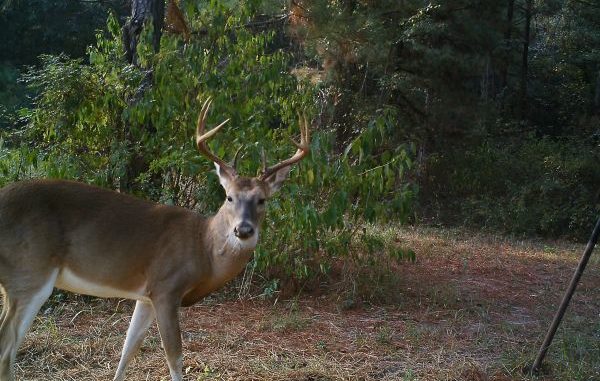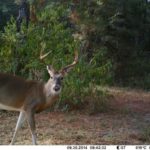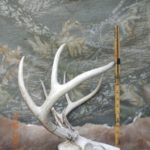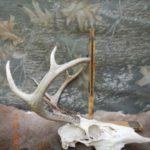
Deer season is in full swing, so it’s time to make trigger decisions — will you shoot that buck when it steps out, or should you let it walk another year. Here are some thoughts to help you make the right choices.
A while back I wrote about the similarities between bass fishing and deer hunting. But there is one major aspect where the two activities are different: When you catch a bass and decide you do not want to keep it you simply drop it back into the water, while when you squeeze the trigger and a buck hits the ground, you cannot take the shot back.
Therefore it is important that — before the trigger is pulled or the arrow released — the hunter is certain he’s looking at a buck he wants to harvest.
“Ground checking” bucks is a poor substitute for field judging live deer.
Current literature indicates the buck harvest in many states is down. Some of this reduction is due to lower deer numbers, and some of this reduction is due to deer hunters limiting their harvest of antler bucks — by mandatory regulations, bag limits or by hunters voluntarily restricting their harvest.
True to course, the antlered buck harvest in Louisiana has declined over the last 10 years. But on the positive side, the harvest of adult bucks in Louisiana has increased, as it has in several other states.
No doubt the increase in Louisiana is due to the three-buck limit, which also might be the reason for the decline in the buck harvest and the subsequent increase in the age structure of the buck harvest; hunters are focusing on shooting adult bucks and are passing up the younger animals.
Kentucky is a state where the buck harvest has increased, as has the number of Boone and Crockett bucks killed annually. Of course, that state has a one buck limit, which I do not think would go over well with Louisiana hunters.
Reducing the harvest of young antlered bucks is a must in order to have older bucks with larger antlers. Of course, habitat is the key to growing bucks with large antlers.
If the nutrition is not present, the age factor alone will not do much. I know of several situations in the state where the landowner developed an older age structure of bucks but, because of either too many deer on the habitat or poor habitat conditions, the adult bucks had small racks.
Adequate nutrition must be present if deer are to have maximum body growth and antler development.
One of the key deer-management issues I have been preaching now for several years is understanding the growth and development trends of your deer herd.
Data collection is a must in order to get the specific information that will show the age structure of your population along with the growth trends for each age class. Many clubs and landowners will initiate buck harvest programs on their land without having the proper information to establish their guidelines.
If the habitat is poor and adult bucks seldom grow racks with 16-inch inside spreads, a program that stipulates only bucks with 8 points and 16-inch spreads can be harvested will not be very successful.
With good data, harvest programs can be established that will allow the harvest of older, quality bucks while allowing younger bucks with good potential to live another year or two.
The data will also point out the low-end bucks in each age class so they can be targeted for removal.
Combining preseason trail-camera data with harvest data is one way to make decisions about what bucks to target before the season opens. Bucks generally are still in bachelor groups prior to the gun season opening up, and setting up cameras at feeders or mineral sites will provide some visual information of the buck antler growth.
It will also give the manager an idea of the current fawn production.
Field judging bucks
There is much information available to hunters concerning field judging bucks. But it is important to know that most of the literature will show you the best growth in each age class.
For instance, most of the yearling bucks that are generally shown in these photos will have 6 to 8 points. This is where knowing the growth trends of your deer herd is a must.
In Louisiana, spikes are probably the norm for the yearling age class, and 6 points are normal for 2 ½-year-old bucks.
I would suggest that you take your data and develop your own standards for growth and development, rather than using data that might not apply to your area.
Main-beam length is one item to look at when field judging deer and when looking at your trail camera photos. The length of the main beam is one of the major points of consideration when scoring deer for the records.
Main beams that are 20-plus inches long can account for 30 to 40 percent of the total Boone and Crockett and Pope and Young scores. A hunter that kills a typical buck with his bow that has main beams 25 inches long already has 50 of the required 125 inches to qualify for Pope and Young.
Consequently, the length of the main beams is something to consider when deciding whether or not to shoot.
Inside spread will give you some idea of main beam length; generally, a buck with a 16-inch inside spread will have main beams that are close to 20 inches long.
Use the ears to determine the inside spread (length between the ears from tip to tip is about 15 inches).
And a hunter should observe how far the tips of the main beams extend over the animal’s head. Main beams typically grow up from the head, curving outward around the head, and then grow forward and upward, with the beams curving in toward each other at the tips. When viewed from above the rack is somewhat basket shaped.
Visualize an imaginary line from the tip of the beam downward to the head; this will give you an idea of main beam length. If the line is close to the eye, then the beams are short — but if the line is halfway to the nose or close to the nose, then the beams are probably 20 inches or more.
Some beams will grow outward from the head and then curve more upward rather than forward. This type of growth makes for tall racks, and in this case simply estimate the length of the beams by using the ear length (usually around 7 inches) as a point of reference.
The length of the individual ears will also give you an idea of the length of individual points. Deer that have G-2s and G-3s 8 or more inches long are pretty good deer. Deer with both G-2s and G-3s 10 inches long add another 40 points to the score.
The eye socket of a deer is about 5 inches in circumference, so that can serve as a reference point for estimating the size of the antler bases. Deer that average 4 inches for each circumference measurement of both antlers will add another 32 points to the score.
Of course, body size in addition to the antlers should also be given consideration. But again, bucks that live on low-quality habitat with poor nutrition will have small bodies.
A nice 8-point rack on the body of a 4 ½-year-old buck that only weighs 140 pounds will make the buck look like a trophy, for sure. But with that body weight, this mature buck should be shot.
Unfortunately, most hunters will think it is just a young buck that will get better and pass on it — while the fact is that the deer is a low-end mature adult that should be harvested.
Young bucks will have small necks and bodies with straight lines on the top of the back and underneath the belly. It makes them look like a rectangular box. It will have the appearance of an adult doe with antlers.
A mature adult buck will have a neck that blends in with its chest — giving the appearance that the deer has no neck — and there will be a dip or sway in its back. Older bucks also will usually have a pot belly.
However, as mentioned above, if the growth trends of the population are low (below average), mature adult bucks with low body weights have the look of a young buck.
It takes time for a hunter to learn the art of field judging deer. The most-important need is to understand the growth and development trends of your herd.
Data collecting is a must for a deer management program so sound harvest strategies can be developed that will work.
But the world will not stop spinning if a hunter kills a young buck with good potential, so let me suggest that your program allow for errors.
Deer hunting is recreation and should bring a certain amount of enjoyment to the hunter.





